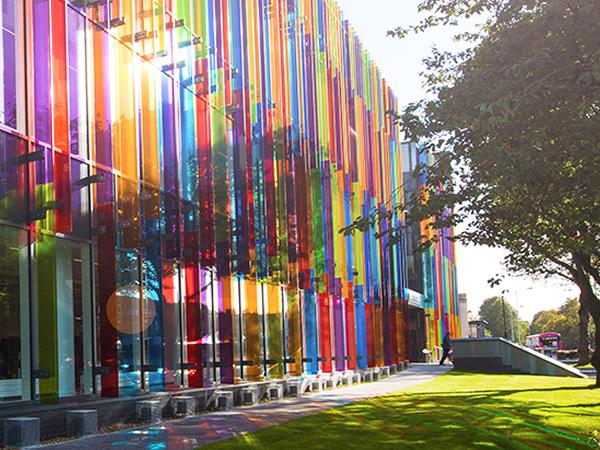Love color and glass? Fire up your imagination! Our Vanceva® color system gives you more than 17,000 colors! Here are our best tricks and tips to make your project glow.
The Vanceva PVB interlayer system offers you one of the world’s most comprehensive choices of color. Using our color system is easy, and here, we answer some of the most frequently asked questions.
What about visible light transmittance (VLT)?
It’s easy to make your selection as transparent, translucent, or solid as you desire. The key is managing VLT. Higher values allow more visible light to pass through the interlayers, while lower values reduce visible light.
What if I want my color choice to include privacy?
Add an interlayer of white, such as Arctic Snow from the Vanceva White Collection, to your combination. Arctic Snow provides a medium, diffuse VLT (~65%) without complete opacity.
I’d like different colors for each side of the glass. Can I do that?
Yes! Place Polar White, which has a low VLT (~7%), in the middle of two color interlayers for a different color on each side of the glass. Or put color on only one side of the Polar White to achieve two-sided color with one white side. All laminates of this construction will be near opaque to opaque.
Does interlayer thickness change the color?
Some of our interlayers are available in 0.38-mm (0.015-in.) thickness and 0.76-mm (0.030-in.) thickness. This may have you wondering if thickness changes the intensity of the color. The answer is no.
Vanceva colors are formulated to provide the same hue and VLT independent of the interlayer’s thickness. So whether you have a 0.38 -m (0.015-in.) or 0.76-mm (0.030-in.) layer, both are formulated to provide the same VLT and hue. Color intensity and VLT remain the same no matter the supplied interlayer’s thickness for that color designation.
Does doubling the interlayer reveal the same results as using a thicker interlayer?
It gets tricky here! Doubling the 0.38-mm (0.015-in.) yields does not yield same results as using 0.76-mm (0.030-in.) layer of the same color designation.
Stacking two 0.38-mm (0.015-in.) layers does provide the same hue as the supplied 0.76-mm (0.030-in.) layer. However, two 0.38 mm (0.015 inch) layers will be significantly darker. Some of our most popular Vanceva Earth Tones interlayers come in two thicknesses, so we get this question quite a bit. The total interlayer gauge for a laminate may be a layered configuration of one layer of color and a layer of clear interlayer — be careful when specifying!
Cracking the code: How to layer up
You can easily navigate questions about thickness selection and target VLT with the Vanceva color code. The layering order is defined by the color code. Each Vanceva color layer is assigned a single character code. Since four layers can be combined, the code will have four characters — each identifying a single layer of interlayer.
These four characters call out the exact order of the layers. It is important that this ordering is strictly adhered to during lamination. Otherwise, the reflected appearance of the color will change from the original specification.
Stacking color layers is easy, and understanding the color code is even easier. For example, combine yellow (code 4) with blue (code 6) to create Vanceva color 0046, representing the correct order of the interlayers used. You can add a third interlayer such as a grey (code 7) to shade the color. The new final code is now 0467. To make it translucent, you can add a fourth layer from our White Collection. Arctic Snow (code 9) would make the code 4679. Each layer is 0.38-mm (0.015-in.) thick.
Should a single-layer color be needed and the 0.38-mm (0.015-in.) interlayer thickness not sufficient to meet the performance requirements, the zeros found in the color code can be filled with the appropriate thickness of Saflex® Clear to achieve the overall desired interlayer thickness. In the case of Vanceva color 0046, that configuration can be specified as 0.76-mm (0.030-in.) thick up to 1.52-mm (0.060-in.) thick. The configuration has 0.76 mm (0.030 in.) of colored interlayer. The “0” designates either Saflex Clear interlayers at 0.38 mm (0.015 in.) or no layer, giving flexibility in the performance design. The total interlayer thickness should be defined in the specification.
For a visual explanation of how to specify color and thickness, go to
https://www.youtube.com/watch?v=Q6TpNBJhqPY&feature=emb_title.
What are my added benefits?
Saflex PVB interlayers for the architectural market are typically clear and engineered to provide a specific function — safety, security, sound, structural, solar, and storm. These interlayers are compatible with Vanceva color interlayers. Used together, your glass project has the performance it needs with the color you desire without having to rely solely on colored float glass.
Can Vanceva be used with only clear glass?
No! Although Vanceva interlayers are displayed on the website and through our samples with 3-mm clear glass (3-mm low-iron glass for whites), the interlayers can be used with virtually any type of glass — from colored or coated to fritted and annealed to strengthened. This makes the choices of color and configuration combinations almost limitless!
Get the real deal: Color samples
One final note: Eastman provides sample laminates that are made with the 3-mm clear glass and interlayer layers in the appropriate order. These laminates are custom made and perfectly sized to evaluate any color selection prior to full mock-up production.
To request a customized color laminated glass sample, visit our color request line on Vanceva.com.




































